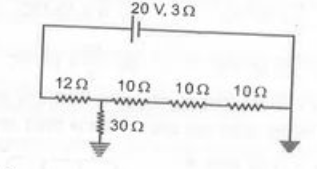The maximum current can be drawn from which of the following cells?
Zn(s)∣∣Zn2+(0.2M)∣∣∣∣Cu2+(0.2M)∣∣Cu(s)
Zn(s)∣∣Zn2+(0.02M)∣∣∣∣Cu2+(0.2M)∣∣Cu(s)
Zn(s)∣∣Zn2+(0.2M)∣∣∣∣Cu2+(0.002M)∣∣Cu(s)
All of these
The correct Answer is:B
To determine which cell can draw the maximum current, we need to calculate the cell potential (E_cell) for each of the given cells using the Nernst equation. The higher the cell potential, the greater the current that can be drawn from the cell.
1. Write the Nernst Equation:
The Nernst equation is given by:
Ecell=E0cell−RTnFlnQ
where:
- Ecell = cell potential
- E0cell = standard cell potential
- R = universal gas constant
- T = temperature in Kelvin
- n = number of electrons transferred in the reaction
- F = Faraday's constant
- Q = reaction quotient
2. Identify the Half-Reactions:
In the given cells, zinc (Zn) is oxidized and copper (Cu) is reduced:
- Oxidation: Zn (s)→Zn2++2e−
- Reduction: Cu2++2e−→Cu (s)
3. Write the Overall Cell Reaction:
The overall cell reaction can be written as:
Zn (s)+Cu2+→Zn2++Cu (s)
4. Calculate the Reaction Quotient (Q):
The reaction quotient Q is defined as:
Q=(Zn2+)(Cu2+)
For each cell, we will calculate Q based on the given concentrations.
5. Calculate Q for Each Cell:
- Cell 1:
- (Zn2+)=0.2, (Cu2+)=0.2
- Q=0.20.2=1
- Cell 2:
- (Zn2+)=0.02, (Cu2+)=0.2
- Q=0.020.2=0.1
- Cell 3:
- (Zn2+)=0.2, (Cu2+)=0.002
- Q=0.20.002=100
6. Analyze the Effect of Q on E_cell:
From the Nernst equation, we see that as Q increases, Ecell decreases (due to the negative sign in front of the logarithm). Therefore:
- Cell 1: Q=1 → Ecell is moderate.
- Cell 2: Q=0.1 → Ecell is higher (more favorable).
- Cell 3: Q=100 → Ecell is the lowest.
7. Determine the Cell with Maximum Current:
The cell with the highest Ecell will be able to provide the maximum current. Since Cell 2 has the lowest Q (0.1), it will have the highest Ecell.
Conclusion:
The cell from which the maximum current can be drawn is Cell 2.
The Nernst equation is given by:
Ecell=E0cell−RTnFlnQ
where:
- Ecell = cell potential
- E0cell = standard cell potential
- R = universal gas constant
- T = temperature in Kelvin
- n = number of electrons transferred in the reaction
- F = Faraday's constant
- Q = reaction quotient
In the given cells, zinc (Zn) is oxidized and copper (Cu) is reduced:
- Oxidation: Zn (s)→Zn2++2e−
- Reduction: Cu2++2e−→Cu (s)
The overall cell reaction can be written as:
Zn (s)+Cu2+→Zn2++Cu (s)
The reaction quotient Q is defined as:
Q=(Zn2+)(Cu2+)
For each cell, we will calculate Q based on the given concentrations.
- Cell 1:
- (Zn2+)=0.2, (Cu2+)=0.2
- Q=0.20.2=1
- Cell 2:
- (Zn2+)=0.02, (Cu2+)=0.2
- Q=0.020.2=0.1
- Cell 3:
- (Zn2+)=0.2, (Cu2+)=0.002
- Q=0.20.002=100
From the Nernst equation, we see that as Q increases, Ecell decreases (due to the negative sign in front of the logarithm). Therefore:
- Cell 1: Q=1 → Ecell is moderate.
- Cell 2: Q=0.1 → Ecell is higher (more favorable).
- Cell 3: Q=100 → Ecell is the lowest.
The cell with the highest Ecell will be able to provide the maximum current. Since Cell 2 has the lowest Q (0.1), it will have the highest Ecell.
The cell from which the maximum current can be drawn is Cell 2.
Similar Questions
Knowledge Check
- Question 1 - Select One
The battery of a trunk has an emf of 24 V. If the internal resistance of the battery is 0.8Ω. What is the maximum current that can be drawn from the battery?
A30AB32AC33AD34A - Question 2 - Select One
In a circuit a cell with internal resistance r is connected to an external resistance R. The condition for the maximum current that drawn from the cell is
AR=rBR<rCR>rDR=0
The electric current drawn from cell is
 View Solution
View SolutionThe storage battery of a car has an emf of 12 V. If the internal resistance of the battery of 0.4Ω, What is the maximum current that can be drawn from the battery ?
View SolutionThe number of maximum normals that can be drawn from any point to an ellipse x2a2+y2b2=1 , is
View SolutionThe number of maximum normals that can be drawn from any point to an ellipse x2a2+y2b2=1 , is
View SolutionThe maximum number of tangents that can be drawn to a circle from a point outside it is…………..
View SolutionThe current I drawn from the 5 volt source will be
 View Solution
View Solution

